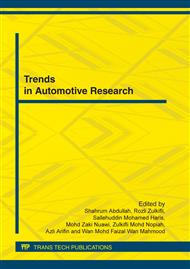p.214
p.219
p.224
p.232
p.237
p.242
p.247
p.252
p.260
Novel Design of Impact Attenuator for an 'Eco Challenge' Car
Abstract:
Thin-walled metallic tubular structures are generally used as impact energy absorber in automotive structures due to their ease of fabrication and installation, high energy absorption capacity and long stroke. However, unlike a normal passenger car where the impact energy can be distributed throughout the whole structure, the impact energy absorbing system of an Eco-Challenge car is confined within a limited space on the front bulkhead. The challenge is to develop an impact attenuator system that can effectively absorb the impact energy within the given space and fulfil the specified rate of deceleration. This new design utilized the standard Aluminium 6063 circular tubes, cut and welded into specific configurations i.e. stacked toroidal tubes with central axial tube sandwiched between two flat plates. Two configurations were investigated; circular and square toroids. Explicit non-linear FEA software was used to determine the impact response i.e. energy absorption, impact force and rate of deceleration. Both configurations showed promising results but the configuration that can be readily fabricated was chosen as the final design.
Info:
Periodical:
Pages:
237-241
Citation:
Online since:
April 2012
Price:
Сopyright:
© 2012 Trans Tech Publications Ltd. All Rights Reserved
Share:
Citation:


